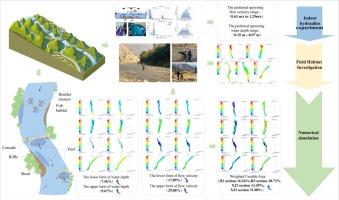裂腹鱼产卵期水动力阈值及生境恢复研究
IF 4.1
2区 环境科学与生态学
Q1 ECOLOGY
引用次数: 0
摘要
水动力阈值对受管制河流中濒危鱼类的产卵栖息地至关重要,但尚未量化。本研究将实验室水槽实验与实地调查相结合,以确定对长江上游地区特有的易受伤害鱼类——南裂胸鱼(S. prenanti)的特定需求。视频跟踪分析确定了金沙江支流的最佳产卵流速(0.63-1.29 m/s)和水深(0.15-0.97 m)。为了恢复退化的栖息地,在优先河段部署了巨石群,显著改变了当地的水力学:最小流速降低了17.89%,最大流速增加了29.00%,水深极值增加了7.56 - 9.67%。水力生境评价结果显示,恢复后的加权可用面积(WUA)增加13.49% ~ 21.08%,证实了产卵适宜性的增强。该研究为石簇恢复是改善南梭子鱼产卵栖息地的有效途径提供了实证支持,并为保护和河流生态系统管理提供了实践目标。这些发现有助于实现生物多样性保护和可持续河流恢复的更广泛目标。本文章由计算机程序翻译,如有差异,请以英文原文为准。

Hydrodynamic thresholds during the spawning period of Schizothorax prenanti and habitat restoration study
Hydrodynamic thresholds are critical yet unquantified for spawning habitats of endangered fish in regulated rivers. This study integrates laboratory flume experiments with field investigations to establish species-specific requirements for Schizothorax prenanti (S. prenanti)—a vulnerable endemic fish in the upper Yangtze Basin. Video-tracking analysis identified optimal spawning flow velocities (0.63–1.29 m/s) and water depths (0.15–0.97 m), validated in Jinsha River tributaries. To rehabilitate degraded habitats, boulder clusters were deployed in priority reaches, significantly altering local hydraulics: minimum flow velocity decreased by 17.89 % while maximum velocity increased by 29.00 %, with water depth extremes rising 7.56–9.67 %. Hydraulic habitat assessment demonstrated post-restoration weighted usable area (WUA) gains of 13.49–21.08 %, confirming enhanced spawning suitability. This study provides empirical support for boulder-cluster restoration as an effective way to enhance S. prenanti spawning habitat and offers practical targets for conservation and river-ecosystem management. The findings contribute to the broader goals of biodiversity conservation and sustainable river restoration.
求助全文
通过发布文献求助,成功后即可免费获取论文全文。
去求助
来源期刊

Ecological Engineering
环境科学-工程:环境
CiteScore
8.00
自引率
5.30%
发文量
293
审稿时长
57 days
期刊介绍:
Ecological engineering has been defined as the design of ecosystems for the mutual benefit of humans and nature. The journal is meant for ecologists who, because of their research interests or occupation, are involved in designing, monitoring, or restoring ecosystems, and can serve as a bridge between ecologists and engineers.
Specific topics covered in the journal include: habitat reconstruction; ecotechnology; synthetic ecology; bioengineering; restoration ecology; ecology conservation; ecosystem rehabilitation; stream and river restoration; reclamation ecology; non-renewable resource conservation. Descriptions of specific applications of ecological engineering are acceptable only when situated within context of adding novelty to current research and emphasizing ecosystem restoration. We do not accept purely descriptive reports on ecosystem structures (such as vegetation surveys), purely physical assessment of materials that can be used for ecological restoration, small-model studies carried out in the laboratory or greenhouse with artificial (waste)water or crop studies, or case studies on conventional wastewater treatment and eutrophication that do not offer an ecosystem restoration approach within the paper.
 求助内容:
求助内容: 应助结果提醒方式:
应助结果提醒方式:


